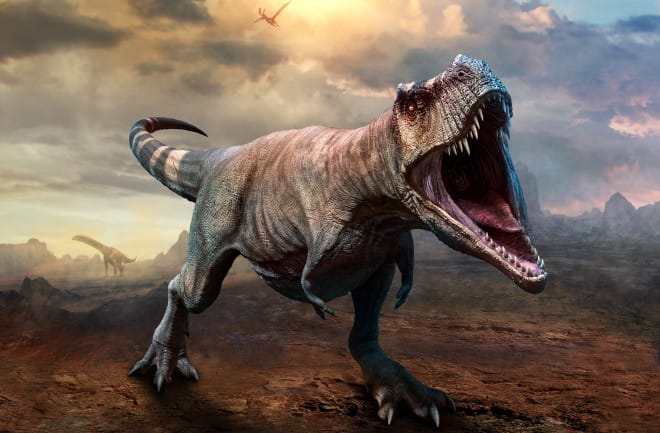Introduction
Mosasaurus hoffmannii is a significant animal in paleontology for several reasons. Firstly, it is the namesake member of the legendary group of Cretaceous marine predators known as mosasaurs. As the largest member of this group, it holds a prominent place in the history of paleontological research. Moreover, this impressive creature played a vital role in the early years of paleontology as a scientific discipline. Lastly, Mosasaurus hoffmannii serves as a clear example of an animal that undoubtedly went extinct due to the catastrophic End-Cretaceous Mass Extinction approximately 66 million years ago.
Mosasaurus and the Evolution of Mosasaurs
Transitioning to the evolution of mosasaurs, Mosasaurus and mosasaurs, in general, are part of the larger lizard group that continues to thrive to this day. These giant mosasaurs, like Mosasaurus, hold the distinction of being the largest lizards ever known to have existed. They originated in the Early Cretaceous from a group of lizards closely related to monitor lizards and snakes.
Initially, mosasaurs were amphibious with functional limbs. During this phase, their reproductive methods remain uncertain. However, over time, these amphibious creatures transitioned into fully aquatic beings, adapting to thrive in marine environments. Their head and neck evolved for better streamlining. Scales reduced in size with grooves to minimize water friction, and they developed large vertical tail flukes similar to ichthyosaurs or metriorhynchid crocodylomorphs. Their limbs transformed into flippers that became useless outside of water, and they eventually gave live birth to avoid the need to return to land. Additionally, they developed a high metabolic rate and a degree of homeothermy, making them skilled sustained swimmers. Interestingly, these adaptations occurred independently in three different lineages of mosasaurs in a remarkable case of parallel evolution, with one of these lineages leading to the mosasaurine mosasaurs, the group from which Mosasaurus eventually emerged.
Mosasaur Diversity and Dominance
Now, let's explore the rapid expansion of mosasaurs into fully marine environments, which was a result of the Cenomanian-Turonian Boundary Event. During this time, ichthyosaurs were wiped out by a cataclysm, and pliosaurs were reduced to only a few taxa less suited for hunting larger prey. As a result, mosasaurs seized the opportunity and became the new dominant marine predators. This event triggered a surge in mosasaur diversity, with different lineages evolving to fill various ecological niches, from agile predators of small schooling fish to giant apex predators.
However, during the Campanian, a subdivision of the Cretaceous period, a significant shift occurred. Most of the giant tylosaurine mosasaurs, including the formidable Tylosaurus, and many speedy plioplatycarpine mosasaurs went extinct. Some large tylosaurines survived but were confined to the southern waters around Antarctica. The mosasaurine mosasaurs, including Mosasaurus, quickly expanded to fill the gaps left by their extinct counterparts. This marked the reign of mosasaurines during the final phase of the Cretaceous, known as the Maastrichtian. During this period, Mosasaurus hoffmannii emerged as one of the dominant apex predators, replacing its tylosaurine relatives.
Mosasaurus hoffmannii - The Largest Apex Predator
Moving on to Mosasaurus hoffmannii, it stands out as the largest mosasaur and lizard ever known. With a length of approximately 13 meters and weighing nearly 10 tons, it was a robustly built creature, typical of mosasaurines. While some claims suggest that Mosasaurus reached 17 meters in length, these often overlook the relatively larger skull of M. hoffmannii compared to many other mosasaurs and the curvature of their back and tail fluke, which resulted in shorter spines. Nonetheless, Mosasaurus was an imposing apex predator 66 million years ago, but it wasn't as large as present-day baleen whales.
The fossils of Mosasaurus hoffmannii have been found in various parts of the world, indicating its widespread presence and adaptability to pelagic ecosystems.
Mosasaur Feeding Habits
Now, let's delve into the feeding habits of mosasaurs. The larger mosasaurs, both mosasaurines and tylosaurines, served as apex predators, preying on various animals of substantial size. Their dental structures were designed for specific functions, including crushing, cutting, and piercing, with some combinations in different mosasaurs. Mosasaurines, including Mosasaurus, had teeth suited for the "pierce-cut" function. Equipped with serrated cutting edges, these teeth allowed them to dismember large prey that couldn't be swallowed whole. Their lower jaw's capability of adduction enabled backward and forward motion, facilitating the process of pulling prey deeper into their throats or producing a saw-like cutting action.
Additionally, mosasaurs evolved a second set of teeth on their upper jaw attached to a movable palate. While this feature was somewhat reduced in Mosasaurus hoffmannii, it still played a role in immobilizing and inflicting further damage to their prey with each bite.
End-Cretaceous Mass Extinction and Conclusion
Finally, let's discuss the End-Cretaceous Mass Extinction and its impact on mosasaurs. Mosasaurine mosasaurs, including Mosasaurus hoffmannii, were at their peak at the end of the Cretaceous, experiencing a second wave of diversification. Their ecological diversity rivaled almost any other group of marine reptiles, surpassed only by the plesiosaurs.
Unfortunately, the impressive reign of Mosasaurus and its mosasaur relatives came to an abrupt end due to the catastrophic End-Cretaceous Mass Extinction caused by a massive asteroid impact. This event marked the end of the Mesozoic era and led to the demise of these magnificent marine predators at the height of their success.
Key Points:
- Mosasaurus hoffmannii is the namesake member of the mosasaurs, a group of Cretaceous marine predators, and the largest among them.
- It played a pivotal role in the early years of paleontology as a scientific discipline.
- Mosasaurus hoffmannii went extinct as a result of the catastrophic End-Cretaceous Mass Extinction.
- Mosasaurs evolved from amphibious to fully aquatic creatures through parallel evolution.
- During the Campanian, mosasaurines replaced their extinct tylosaurine counterparts as dominant marine predators.
- Mosasaurus hoffmannii stood out as the largest apex predator, adapting well to pelagic ecosystems.
- Mosasaurines, including Mosasaurus, had specialized dental adaptations for slicing and dismembering prey.
- The End-Cretaceous Mass Extinction ended the reign of mosasaurs, including Mosasaurus, at their peak of ecological diversity.



